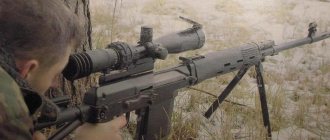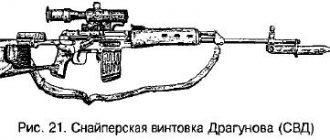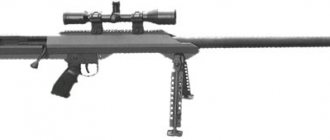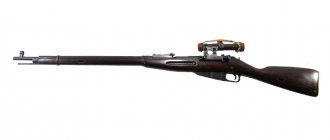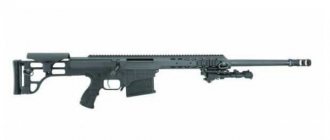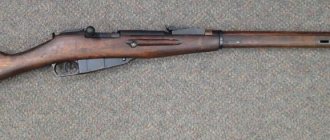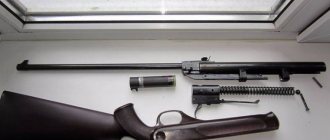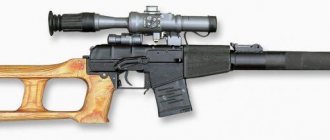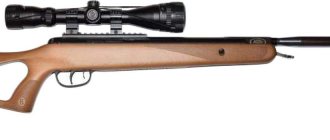The Dragunov rifle is perhaps the most famous example of a sniper weapon in the world.
For more than half a century since its adoption, the SVD has taken part in almost all military conflicts in the world. Four dozen countries have adopted the Dragunov rifle, collectors of the civilian arms market around the world are hunting for it, in the United States they are arguing about it, citing various arguments, both specialists and armchair analysts. And in how many films and games the elegant and thin SVD with its characteristic butt and wooden stock appeared - it’s difficult to list. The beloved and hated sniper (or “precision combat”) rifle - these are its characteristics, and today we are talking about the legendary SVD.
7.62 mm Dragunov SVD sniper rifle
SVD sniper rifle designed by Dragunov
Dragunov sniper rifle with a plastic butt and fore-end Photo (c) KardeN
The 7.62 mm Dragunov sniper rifle (SVD, GRAU Index - 6B1) was developed in 1957-1963. a group of designers led by Evgeniy Dragunov. In the Western space, the SVD is considered an improved combat rifle, and not a sniper rifle (a high-precision rifle for professional snipers), that is, a Marksman rifle - a weapon of an infantry sniper (“Marksman”), occupying an intermediate position between conventional small arms and heavier high-precision sniper rifles with longitudinal sliding butterfly valve.
In the mid-1960s, changes were made to the technical processes for the production of the Dragunov SVD sniper rifle: gunsmiths I. A. Samoilov and V. Nikitin developed a new barrel manufacturing technology. In the 1990s, the rifle began to be equipped with a plastic forend. In addition, the production of a conversion version of the rifle was mastered - the Tiger self-loading carbine (structurally distinguished by a shorter barrel, the absence of a flash suppressor, a gas regulator and a lug for attaching a bayonet, and modified fittings).
The SVD uses 7.62×54 mm R rifle cartridges with ordinary, tracer and armor-piercing incendiary bullets, as well as sniper cartridges (7N1, 7N14); it can also fire cartridges with JHP and JSP expansion bullets.
The Dragunov SVD sniper rifle fires in single shots. When firing, cartridges are supplied from a box magazine with a capacity of 10 rounds. A flash suppressor with five longitudinal slots is attached to the muzzle of the barrel, which also masks the shot during night operations and protects the barrel from contamination. The presence of a gas regulator for changing the recoil speed of moving parts ensures the reliability of the rifle in operation. The rifle is equipped with a PSO-1M2 optical sight; it is possible to install NSPUM or NSPU-3 night sights.
The automation of the SVD rifle is based on the use of the energy of powder gases diverted from the barrel bore to the gas piston. When fired, part of the powder gases following the bullet rushes through the gas outlet hole in the barrel wall into the gas chamber, presses on the front wall of the gas piston and throws the piston with the pusher, and with them the bolt frame, to the rear position.
When the bolt frame moves back, the bolt opens the barrel, removes the cartridge case from the chamber and throws it out of the receiver, and the bolt frame compresses the return spring and cocks the hammer (puts it on the self-timer).
The bolt frame with the bolt returns to the forward position under the action of the return mechanism, while the bolt sends the next cartridge from the magazine into the chamber and closes the bore, and the bolt frame removes the self-timer sear from under the self-timer cocking of the hammer and the hammer is cocked. The bolt is locked by turning it to the left and inserting the bolt lugs into the cutouts of the receiver.
To fire the next shot, you must release the trigger and press it again. After releasing the trigger, the rod moves forward and its hook jumps behind the sear, and when you press the trigger, the rod hook turns the sear and disconnects it from the cocking of the hammer. The trigger, turning on its axis under the action of the mainspring, strikes the firing pin, and the latter moves forward and punctures the igniter primer of the cartridge. A shot occurs.
When firing the last cartridge, when the bolt moves back, the magazine feeder raises the bolt stop, the bolt rests on it and the bolt frame stops in the rear position. This is a signal that you need to load the rifle again.
In 1991, the SVDS rifle was adopted for the airborne troops, which was an SVD with a barrel shortened by 5.5 cm and a folding butt.
Purpose
The 7.62 mm Dragunov sniper rifle is a sniper weapon and is designed to destroy various emerging, moving, open and camouflaged single targets.
The rifle is equipped with a PSO-1 sniper scope. The optical sight allows you to target infrared sources at night, as well as under unfavorable lighting conditions, when it is difficult to shoot at targets with an open sight.
When observing infrared sources, the infrared rays emitted by the source pass through the scope lens and affect the screen located in the focal plane of the lens. At the location of the infrared rays, a glow appears on the screen, giving a visible image of the source in the form of a round green color.
For shooting from a sniper rifle, rifle cartridges with ordinary, tracer and armor-piercing incendiary bullets or rifle sniper cartridges are used.
Fire from a sniper rifle is carried out in single shots.
When firing, cartridges are supplied from a box magazine with a capacity of 10 rounds.
Firing accuracy
In accordance with the “Manual on Shooting,” the accuracy of a rifle is considered normal if, when firing four shots from a prone position at a distance of 100 m, all four holes fit into a circle with a diameter of 8 cm. Shooting is carried out with cartridges taken from a hermetically sealed container from the same batch with ordinary bullets with steel core.
Initially, the SVD was produced with a rifling pitch of 320 mm, similar to sporting weapons and ensuring high accuracy of fire, however, when the Dragunov sniper rifle was put into service, it turned out that with this pitch the dispersion of the B-32 armor-piercing incendiary bullets doubles. As a result, it was decided to change the rifling pitch to 240 mm, which led to an increase in the dispersion standard at a distance of 100 m from 8 cm to 10 cm (which, however, was not reflected in the NSD). When firing with a 7N1 sniper cartridge, the dispersion is (depending on the pitch of the rifling) no more than 10-12 cm at a distance of 300 m.
The direct shot range of the Dragunov SVD sniper rifle is:
- according to the head figure, height 30 cm - 350 m,
- according to the chest figure, height 50 cm - 430 m,
- according to a running figure, 150 cm high - 640 m.
The PSO-1 sight is designed for shooting up to 1300 meters, but at such a range you can only effectively shoot at a group target, or conduct harassing fire.
The main difficulty when shooting at long ranges is the errors in preparing the initial data for shooting (this is true for all sniper rifles). At a range of 600 meters, the median error in height (in determining the range equal to 0.1% of the range) is 63 cm, the median error in the lateral direction (determining crosswind speed equal to 1.5 m/s) is 43 cm. For comparison, The median deviation of bullet dispersion for the best snipers for 600 m is 9.4 cm in height, 8.8 cm in lateral direction.
Good sniper training allows you to conduct targeted fire even at targets such as helicopters and low-speed aircraft. For example, there is a known case when a fighter of the FMLN partisan detachment managed to shoot down a jet attack aircraft of the El Salvadoran Air Force with a shot from an SVD. This happened on November 12, 1989 near the village of San Miguel. The Cessna A-37B aircraft coming into the attack successfully fit into the sight and was hit (later the successful sniper said that he was aiming at the cockpit). The bullet hit the pilot, after which the plane lost control and crashed. Iraqi militants used SVD in a similar way, claiming to have destroyed RQ-11 Raven small reconnaissance UAVs with sniper rifle fire.
Closed type DTK for the SVDS rifle (Art. 00227)
35,000 rub.
Add to cart The lack of a long flame arrester on the SVDS does not allow us to install a “silencer” of our production in the same way as on the SVD, so we had to develop a special base:
The base is attached like a clamp to the end of the SVDS barrel and allows you to screw a “silencer” onto itself.
This additional base comes complete with the SVDS “muffler”; its installation does not require complex equipment or serious plumbing skills; everything can be done even in the field, with only a flat-head screwdriver.
Characteristics of the Dragunov sniper rifle
- Caliber: 7.62×54R
- Weapon length: 1225 mm
- Barrel length: 547 mm
- Weapon width: 88 mm
- Weapon height: 230 mm
- Weight without cartridges: 4.3 kg.
- Magazine capacity: 10 rounds
Sniper rifles
- Austria
- Hungary
- Brazil
- Czech
- South Africa
- France
- USA
- Russia/USSR
- Finland
- Uruguay
- Israel
- Germany
- Türkiye
- Switzerland
- South Korea
- Japan
- Belgium
- Poland
- Ukraine
- Croatia
- Serbia
- China
- Canada
- Great Britain
SVDK
In 2006, the army adopted a multi-caliber sniper rifle, which was created for a 9 mm cartridge on the basis of the SVD. The weapon was created specifically to defeat an enemy who is behind an obstacle and has protective equipment (body armor), including light equipment.
The design of the SVDK rifle is an upcoming development of the SVD, but the main components have been modernized, they are designed to use a more massive cartridge:
- part of the rifle barrel was placed in a special casing;
- The folding iron stock and pistol grip were borrowed from the SVDS sniper rifle, but at the same time, the area of the rubber butt plate was noticeably increased due to stronger recoil during shooting.
The SVDK rifle, unlike the SVD, does not have the ability to strengthen the bayonet. For the best durability when firing with a massive 9-mm cartridge, the gun is equipped with a bipod. SVDK, like the SVD rifle, in addition to the special 1P70 Hyperon optical sight, also has an open sight.
Ammunition
As mentioned earlier, the caliber of the SVD is 7.62x53. The rifle is fed from a double-row metal box-shaped detachable sector-shaped clip, the capacity of which is ten rounds. The designers provided for the location of the magazine in such a way that the center of gravity of the weapon was located above it. As a result, cartridge consumption has virtually no effect on the balance of the rifle, and therefore on the displacement of the average point of impact. For shooting from the Dragunov sniper rifle, in addition to the special 7N1 cartridge, they also use the 57-N-223 rifle cartridge with a lightweight bullet, 7T2 with a tracer bullet, as well as 7B3 with an armor-piercing incendiary charge, etc.
Excerpts from the Soviet Military Encyclopedia
Snipers are specially trained shooters who are fluent in the art of camouflage, observation and marksmanship; able to hit targets with the first shot. Officially, the first snipers appeared in the British army during the First World War. The main task of such fighters is to destroy important moving, open, camouflaged and emerging single targets. These could be enemy snipers, observers, officers, messengers, etc. The shooter is armed with a rifle equipped with a special sight. For shooting, he selects and equips a hidden position. During the Second World War, all participants in the armed conflict widely deployed sniper training; for this purpose, special schools were created, training camps and courses were held. In the USSR, the mass mastery of this art was called the sniper movement. In addition, this concept became a household word, as a result it began to be used to refer to accurate shooters of aviation, artillery and tank forces.
Sniper rifles are equipped with optical sights that improve aiming accuracy and provide good observation in any conditions. To fire at night, night vision sights are installed on weapons or the optical reticle is illuminated. Until the early 60s of the last century, the Soviet Army did not have specialized sniper rifles in service, but Mosin carbines of the 1891/30 model were used. However, methods of warfare changed, and the experience of past local conflicts set a number of requirements for sniper work. Thus, a new stage has begun in the development of this type of weapon. Now all elements, from the cartridge and optical sight to the rifle, were developed and manufactured according to special orders.
Concept of use
For hand-to-hand combat, a standard type bayonet (6X4) can be attached to the SVD. Although this attribute on a sniper rifle is very rare and hardly necessary. Nevertheless, we should not forget that this weapon was created as equipment for small sabotage units, and this obliged us to provide for its use even in close combat.
In general, the design of the SVD, the characteristics of which turned out to be quite impressive, was a very successful compromise between general combat and sniper requirements. In addition, it should be noted that this rifle became the first army weapon, the design of which clearly showed the features of sports equipment. For the 60-70s of the last century, the SVD had very high accuracy. Experience suggested that with the help of this sniper rifle it was possible to hit low-visibility targets at a distance of up to 800 meters. The range of the SVD against a target of the “chest figure” type (50x50 cm) reaches 600 meters, and against a “head figure” (25x30 cm) - 300 meters.
SVD stock and butt
The SVD rifle has a characteristic cutout in the butt, which forms a pistol grip with its front edge. The frame shape allows you to hold the weapon with your left hand, shooting from a rest. A non-adjustable, removable cheekpiece and butt pad can be attached to the buttstock. The forend is formed by two symmetrical barrel linings, which have slots for better cooling of the rifle. The linings are equipped with a spring-loaded mount, so that the fulcrum of the stock is on the axis of the barrel. As a result, the force created by the hand supporting the rifle does not affect the shooting results. In addition, when the barrel lengthens, caused by its heating during firing, the forend moves slightly forward; Since the engagement conditions do not change, there is no shift in the so-called midpoint of impact. Since the beginning of its existence, the SVD (the photos given in this article demonstrate the weapon we are considering) has undergone several stages of modernization. As a result, the wooden butt and fore-end were replaced with a plywood board, and the modern modification is available with a plastic butt and black glass-filled polyamide linings. Thanks to these changes, the weight of the SVD decreased.
With the world on a thread...
The development of ammunition for the new rifle was carried out by employees of the research institute No. 61 V. M. Sabelnikov, P. F. Sazonov and V. N. Dvoryaninov. This cartridge with a bullet having a steel core was adopted for service four years after the rifle itself ( in 1967) and received the index 7H1. Soviet engineers A. I. Ovchinnikov and L. A. Glyzov were responsible for the development of the PSO-1 optical sight. The technology for producing a high-precision barrel for this rifle was developed by I. A. Samoilov. Evil tongues often mention the similarities between the SVD and AK systems, they note that They are almost identical automatic with removal of powder gases from the barrel through a side hole, locking the channel by turning the bolt and a double-action non-automatic safety lever. In addition, the hammer strike mechanism has a similar form of mainspring. There is no doubt that certain elements were borrowed from the AK, but the SVD rifle is not a copy of the machine gun, it is an independent system, and the proof of this is the features of this weapon, which we present below.
